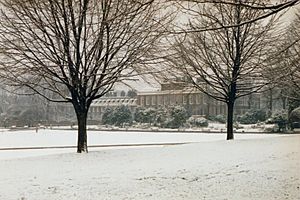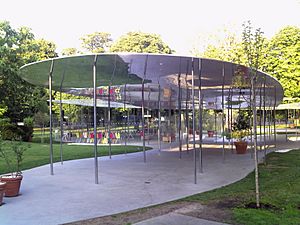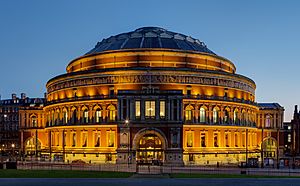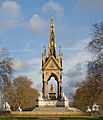Kensington Gardens facts for kids
See also Kensington Gardens, South Australia, a suburb of Adelaide, Australia
Kensington Gardens, once the private gardens of Kensington Palace, are among the Royal Parks of London. The gardens are shared by the City of Westminster and the Royal Borough of Kensington and Chelsea and sit immediately to the west of Hyde Park, in western central London. The gardens cover an area of 275 acres (1.1 km²). Most of it is in the City of Westminster, but a small section to the west is in the Royal Borough of Kensington and Chelsea.
The open spaces of Kensington Gardens, Hyde Park, Green Park, and St. James's Park together form an almost continuous "green lung" in the heart of London. Kensington Gardens are Grade I listed on the Register of Historic Parks and Gardens.
Background and location
Kensington Gardens are generally regarded as being the western extent of the neighbouring Hyde Park from which they were originally taken, with West Carriage Drive (The Ring) and the Serpentine Bridge forming the boundary between them. The Gardens are fenced and more formal than Hyde Park. Kensington Gardens are open only during the hours of daylight, whereas Hyde Park is open from 5 am until midnight all year round.
Kensington Gardens has been long regarded as "smart" because of its more private character around Kensington Palace. However, in the late 1800s, Hyde Park was considered more "fashionable," because of its location nearer to Park Lane and Knightsbridge.
History
Kensington Gardens was originally the western section of Hyde Park, which had been created by Henry VIII in 1536 to use as a hunting ground. It was separated from the remainder of Hyde Park in 1728 at the request of Queen Caroline and designed by Henry Wise and Charles Bridgeman in order to form a landscape garden, with fashionable features including the Round Pond, formal avenues and a sunken Dutch garden.
Bridgeman created the Serpentine between 1726 and 1731 by damming the eastern outflow of the River Westbourne from Hyde Park. The part of the Serpentine that lies within Kensington Gardens is known as "The Long Water". At its north-western end (originally the inflow of the River Westbourne) in an area known as "The Italian Garden", there are four fountains and a number of classical sculptures. At the foot of the Italian Gardens is a parish boundary marker, delineating the boundary between Paddington and St George Hanover Square parishes, on the exact centre of the Westbourne river.
Buildings
The land surrounding Kensington Gardens was predominantly rural and remained largely undeveloped until the Great Exhibition in 1851. Many of the original features survive along with the Palace, and now there are other public buildings such as the Albert Memorial (at the south-east corner of Kensington Gardens, opposite the Royal Albert Hall), the Serpentine Gallery, and Speke's monument.
The park also contains the Elfin Oak, an elaborately carved 900-year-old tree stump.
In popular culture
The park is the setting of J.M. Barrie's book Peter Pan in Kensington Gardens, a prelude to the character's famous adventures in Neverland. The fairies of the gardens are first described in Thomas Tickell's 1722 poem Kensington Gardens. Both the book and the character are honoured with the Peter Pan statue by George Frampton located in the park.
Rodrigo Fresán's novel Kensington Gardens concerns in part the life of J.M. Barrie and of his creation Peter Pan, and their relationship with the park, as well as the narrator's own.
The Infocom interactive fiction game Trinity begins in the Kensington Gardens. The player can walk around many sections of the gardens, which are described in moderate detail.
Images for kids
-
The Diana, Princess of Wales Memorial Playground (erected on the site of the existing Peter Pan children's playground) is inspired by Peter Pan.
-
Physical Energy sculpture
-
The Albert Memorial
See also
 In Spanish: Jardines de Kensington para niños
In Spanish: Jardines de Kensington para niños

















